Bones are supposed to last a long time. They decompose very slowly after we die, lasting for thousands of years under certain circumstances. In fact, the strength and durability of bones made them excellent for creating a variety of tools and weapons in historical times. They are not supposed to deteriorate while we are still alive! So why are so many people suffering from bone loss? Most people presume that a lack of dietary calcium is the culprit, so they load up on dairy products or calcium supplements in an effort to slow the progression of bone loss.
But, there is much more to the story of building and maintaining strong bones. Although calcium is an important player in bone health, there are several other nutrients and factors that are also necessary for strong bones, and the imbalance or absence of any one of them will interfere with maintaining bone density.
What are Bones Made of?
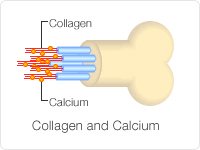
Bones are made of two main components: 1) a latticed protein structure called the collagen matrix that gives bones their flexibility, and 2) calcium phosphate (an insoluble salt of calcium and phosphorus), also known as hydroxyapatite, which makes up most of the bone mass and gives bones their hardness.
Collagen is needed for trapping calcium and holding it in the bones.
The bones are also a reservoir for other minerals needed by the body such as magnesium, sodium, potassium, phosphorous, copper, manganese, zinc, strontium (chemically similar to calcium) and boron. The ability of the bone to absorb and hold on to calcium salts and other minerals is called mineralization.
Even though bones are strong and hard, they are not like rocks or stones. They are very much like other tissues in the body which are continuously being broken down and built up again to form new bone. The process of building new bone is called deposition, or formation, and the process of breaking down bone is called resorption.
Bone resorption basically dissolves bone tissue and releases the minerals, resulting in a transfer of calcium from bone tissue into the bloodstream to be used for many bodily functions.
During your lifetime, your body continues to both reabsorb old bone and create new bone. In adults, about 5 to 10 percent of bone is replaced each year in this fashion. In fact, your entire adult skeleton is replaced about every ten years, though this process slows as you get older.
As long as your body has a good balance of new and old bone, your bones stay healthy and strong.
What is Bone Loss? 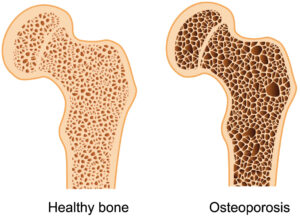
Bone loss occurs when more old bone is resorbed than new bone is created, causing the bones to become more porous. Bone loss, or osteoporosis, is a disease that causes bones to become brittle and more likely to fracture (break). Brittle, fragile bones can be caused by anything that makes your body destroy too much bone or keeps your body from making enough new bone.
The Role of Calcium in the Body and in Bone Health
We need and use more calcium than any other mineral in the body. In fact, there are 179 different known uses for calcium in the human body. The most notable function is that it is one of the major electrolytes and is used throughout the body in electrical communications such as muscle contraction and relaxation, nerve transmission, and the transfer of information between our brain cells.
Calcium controls the rhythm of the heartbeat, the formation of hormones, and also the DNA formation in chromosomes. Calcium is used in blood clotting, and of course in the formation and maintenance of the bones and teeth.
Perhaps most importantly, calcium is used as the main buffer to neutralize acids and to maintain the proper pH in the blood and throughout the body.
How Calcium is Absorbed
When you consume foods or supplements that contain calcium, some of that calcium is freed up from the food matrix and dissolved in your digestive tract. Some of it remains undissolved in undigested parts of the food and is excreted through the bowels.
The calcium that is dissolved is absorbed into your bloodstream with the help of vitamin D and transported to the various parts of the body that need calcium for the functions mentioned above. Whatever calcium isn’t needed for other purposes will be deposited in the bones.
It’s important to mention that most calcium absorption is totally dependent on the presence of vitamin D in the intestine. Without intestinal vitamin D being present, your body can only absorb 10-15% of the calcium you consume.
In addition to vitamin D, absorption of calcium and deposition into the bones also depends on the presence of other essential nutrients, including magnesium, boron, phosphorous, strontium, potassium, fluoride, zinc, copper, manganese, silicon, choline, vitamins A, C, and K, and the amino acids lysine, glycine and proline.
pH Balance for Better Bones 
Inability to absorb enough calcium is only part of our problem. We also need to keep our body chemistry (pH) properly balanced to maintain the balance between breakdown of old bone and rebuilding of new bone.
pH is a chemistry term that stands for potential hydrogen. It is always written with a lowercase p and an uppercase H (the chemical symbol for the element hydrogen). Acidic solutions contain more hydrogen than oxygen, whereas alkaline solutions contain more oxygen than hydrogen.
The amount of hydrogen in a solution can be measured by something called the pH scale, which ranges from 0 to 14. Solutions with a pH below 7 are acidic; solutions with a pH above 7 are alkaline. The pH of human blood and cellular fluids is designed to be kept slightly alkaline, at a pH of 7.4.
The hydrogen in acidic solutions makes them corrosive, which means they can be quite damaging. In the seventeenth century, an amateur chemist named Robert Boyle first observed that an acidic solution will become less acidic when mixed with an alkaline solution, and vice versa. In other words, acidic and alkaline solutions counteract each other. This phenomenon is called neutralization.
The key message here is that if enough alkaline solution is added to an acid, the acid will be transformed into an alkaline solution.
Now let’s apply this concept to your body and bones. Acids are naturally formed by normal body functions. For instance, the muscles create lactic acid during exercise. Breathing, cell building, and burning calories to fuel the metabolism are also normal functions of the body that create acid. These acids end up in the blood and need to be neutralized to prevent them from doing damage in the body.
To prevent this damage, and to keep our body functioning properly, we have built-in mechanisms designed to maintain the alkaline pH of our blood at 7.4. The way it does this is through neutralization. Our body makes its own alkaline solution to neutralize acids by drawing from its alkaline reserve, which consists of certain minerals that are stored in our bones, tissues, and teeth. These minerals are drawn upon every time our body needs to neutralize acid.
This is a highly delicate balance, and if the blood pH goes even a little too high or low, serious consequences, including death can occur. For example, an alkaline blood pH of 7.9 may cause lockjaw or tetany and be fatal, while an acid pH of 6.9 causes diabetic coma and may also be fatal.
Maintaining the blood pH at 7.4 keeps the body in homeostasis, or inner balance.
A healthy body maintains adequate alkaline reserves to meet the demands of acidity created by normal body functions. But we create additional acid in our body based on what we eat, and the minerals in our alkaline reserve are not infinite, so it is up to us to replenish them regularly.
Therefore, what we eat and drink is very important in maintaining our alkaline pH. 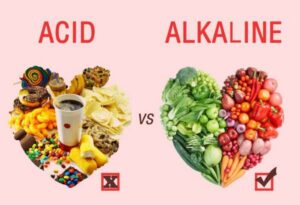
As you may have guessed, certain foods will create alkalinity in our body and replenish our alkaline reserve, whereas some foods create acidity. All foods, after they are digested and metabolized, will leave either acid- or alkaline-forming minerals in our body.
The alkaline-forming foods are those that predominantly supply calcium, sodium, magnesium, potassium, iron, and manganese. Most fruits and vegetables contain the alkaline forming minerals, as well as some whole grains, nuts seeds and unprocessed fats/oils. The majority of our diet should consist of these foods.
The acid-forming foods are those that predominantly supply copper, bromine, fluorine, chlorine, iodine, phosphorus, sulfur, and silicon. Meats, poultry, fish, most grains, legumes, nuts, seeds, and dairy products contain acid forming minerals. These foods can be included in our diets, but they should be eaten in much smaller quantities compared to the alkaline forming foods.
The most acid-forming foods are refined carbohydrates—white sugar and white flour—in addition to most bottled refined cooking oils, sodas (especially diet sodas), artificial sweeteners, alcohol, and prescription drugs. These substances should be extremely minimized or eliminated altogether.

Eating too many of the acid-forming foods and not enough of the alkaline-forming ones results in excess acidity, which overwhelms the body’s alkaline reserve. It’s like continuing to draw money out of a dwindling savings account without replacing it. Ideally, you should have more than you need to ensure you have enough in case of an emergency.
The alkaline reserve consists mainly of calcium, which is drawn from the bones, tissues, and teeth. When calcium is continually removed from the bones, without adequate replacement, you end up with a calcium deficiency, which leads to osteoporosis.
Replenish your alkaline reserve to maintain proper body pH
If we start to add up all the nutrients that are necessary to maintain bone health, we will see that what we end up with is…whole processed-free food! The simplest thing we can do is stop eating processed foods and begin to eat more calcium containing foods. This means that we need to eat 6-8 servings of vegetables and 2-3 servings of fruit each day.
It is important to eat real foods that contain calcium, because they have the other trace minerals needed for absorption. Vegetable choices should consist of dark green leafy types such as collard greens, kale, cabbage, and broccoli, for their high calcium content. Other food sources for calcium are almonds, asparagus, blackstrap molasses, buttermilk, carob, cheese, figs, filberts, goat’s milk, kelp, mustard greens, oats, prunes, sesame seeds, tofu, turnip greens, watercress, whey, and yogurt. Food sources of lysine include cheese, eggs, fish, lima beans, yogurt, potatoes, organic meats, and protein powders.
If supplements are needed, be sure to look for one that contains many of the natural nutrients from foods.
Dee’s Recommended Bone Health Supplements

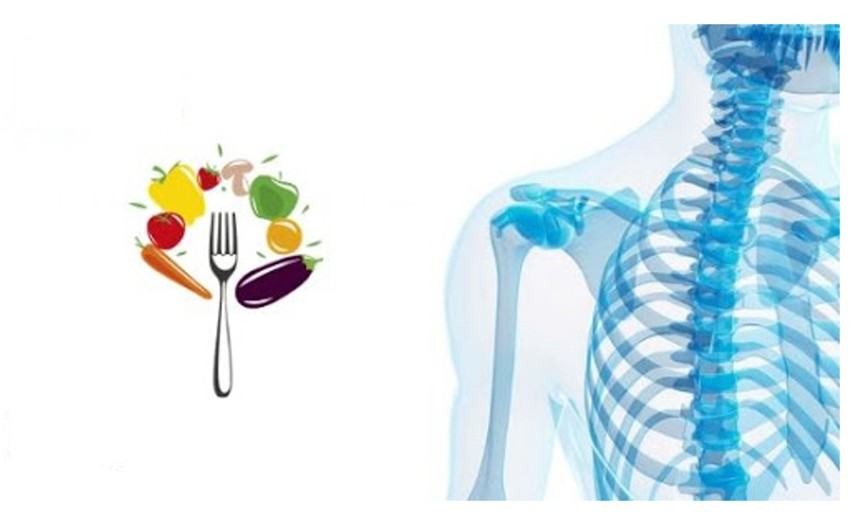
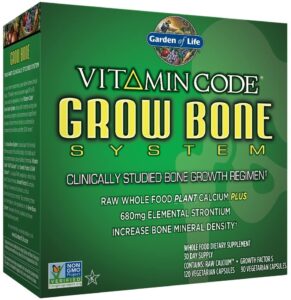
Your explanations of how nutrition affects health has brought meaning and purpose to the statement, “You are what you eat!” Thank you👍💕☯️🙏☮️TY